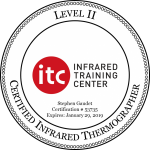Every buyer of a new home should understand the limits of a home inspector. The home inspection is limited to a visual inspection only. This means if the inspector cannot see it, it will not be reported. Why is this important? Experience has shown me that there are sellers out there who will try anything to hide home defects. Imagine that, someone selling a house with problems hiding the fact there is an issue.
If the home inspector your looking to hire is not ASHI certified odds are they have not completed the minimum requirements of 250 inspections. ASHI standards are the highest in the industry, a non-certified inspector may put your purchase at risk.
Below are the Standards of Practice with ASHI & the state of New Hampshire:
ASHI Standards of Practice states
2.2 The inspector shall:
A. inspect readily accessible, visually observable, installed systems and components listed in this Standard.
New Hampshire Standards of Practice states;
<snip>
(j) “Home inspection” means the process by which an inspector visually examines the readily accessible systems and components of a home and which describes those systems and components in accordance with these standards of practice.
<snip>
(p) “Readily accessible” means available for visual inspection without requiring moving of personal property, dismantling, destructive measures, use of a ladder, or any action which will likely involve risk to persons or property.
On a recent inspection of a 100+ year of home, my thermal camera found a heat issue on the electrical main entering the house. Under normal circumstances the main lines would only be exhibiting 50 to 60° of heat. To my surprise one 120v leg is running at 130° in a vacant home. None of the circuit breakers are displaying any heat issues. Something is drawing power between the electrical main shutoff and this panel.


Older homes sometimes have aluminum and copper wiring. Aluminum and copper heat up at different temperatures. If they’re improperly connected together the connection can create an arc overheat and cause a possible fire. Another possible problem could be a lighting solution that has over wattage bulbs on a circuit. Recessed lighting fixtures will state maximum wattage of bulb allowed. If a weak lighting solution was installed the homeowner often installs higher wattage bulb solution not realizing this can overheat and cause a fire hazard.
With thermal imaging I have detected both of these flaws, not found in this home. An electrician is needed to evaluate in repair this problem. Without thermal imaging it would clearly go unnoticed.
When inspecting the attic space I was on the lookout for any signs of moisture, mildew or mold. During the roof inspection I found the tin roof was improperly installed over existing asphalt shingles. The issue here is the old asphalt roof is still deteriorating; now at an accelerated rate due to heat generated from the tin roof. To make matters worse the installer never placed horizontal strapping to allow for air flow. How did I know the roof was installed improperly? I took it apart in one corner and looked. Most inspectors would look at it and “assume” it fine. Keep reading it’s not.
If you not familiar with tin roofs you may not know that during cold mornings they not only frost up on top they also have frost buildup on the underside. Once this frost starts to melt it needs a place to go. If the existing roof is leaking it’s going to enter the home every time there is a frost. The attic space was sealed off making inspection difficult but not impossible. There was a knee wall that allowed me to remove the insulation and look up in between the rafters. As you’ll see in the photo below the homeowner was trying to seal water leaks from the inside with roofing tar. Now the attic has two problems, a roof leak and mildew issues. (I cannot call it mold because I do not test for it.)

Ever diligent, I came across fire damage in the attic. At that point I asked the seller’s realtor if this was disclosed. Answer no. As I continued my inspection I came across extensive fire damage which I was able to show the buyer and the seller’s realtor.
The seller’s realtor called the seller and asked about the fire damage which was initially denied, as more damaged was uncovered the seller’s memory seem to improve. Only at this time did the seller divulge there was a previous fire. Unfortunately I have no more information on the cause or the solution. The area which I found the fire damage was between the main panel and the subpanel in the floors below. Was it related to the fire damage? I have no way of knowing.
Now we need 4 professionals, a licensed electrician for the main panel. Next a structural engineer to review the fire damage to the roof framing members. A roofer to review the improperly installed roof. Last a mold remediation company to review the mildew/mold stains.
Without the experience to know what to look for these problems may have gone unnoticed and no one would be at fault, it’s not visible. Installed insulation covered the fire damage and the moisture issues. If the inspector just looked without moving the insulation it would have gone unnoticed. Without thermal imaging you would never know about the heat issue on the main panel.
Final point, above in the SOP it states an inspector does not need use of a ladder. As you can clearly understand, without one the improper roof install would of been missed.
Buyer beware, this is the difference between a cheap unexperienced inspector and one with experience who brings all the right tools and knowledge to the inspection.





